Archive for January 2018
Saturday, August 5: This morning, I leave Nara for the convoluted three-hour journey to Mount Kōya. I take the Yamatoji Line from Nara Station, and at Tennoji Station I change to the Osaka Loop Line to Shin-Imamiya Station, where I take the Nankai-Koya line to Hashimoto Station, about a 45-minute ride. From Hashimoto, I stay on the same line for another 50 minutes to Gokurakubashi Station, where I take the Nankai Koyasan Cable Car up to Mount Kōya. It’s only a 5 minute ride up the cable car.
Below are some views as we climb the mountain.

view from the cable car

view from the cable car

route from Nara to Mount Koya
The sacred mountain of Kōyasan wears a mantle of mystery and holiness. Situated south of the Kinokawa River in Wakayama Prefecture, Kōyasan sits in a basin on a mountain 820 meters above sea level. Kūkai (774-835), a Japanese Buddhist monk posthumously known as Kōbō-Daishi, sent his disciples to explore Kōyasan beginning in 816. It was granted to Kūkai as a place of meditation by the Imperial Court 1,200 years ago. Kūkai was also a civil servant, scholar, poet and artist who founded the Shingon, or “True Word” school of Buddhism. Practitioners at Kōyasan try to identify themselves with the Buddha by spiritual unification.
Ever since the monastic center was formed, Kōyasan has been a holy pilgrimage destination, and also home to unique cultural assets. In 2004, UNESCO designated Mt. Kōya, along with two other locations on the Kii Peninsula, Yoshino and Omine, as well as Kumano Sanzan, as World Heritage Sites: “Sacred Sites and Pilgrimage Routes in the Kii Mountain Range.”
From Kōyasan Station, I must take a bus to Kongo Sanmai-in, where I’ll be staying overnight in a Buddhist temple. Upon my arrival at the temple lodging, I find it’s too early to check in, so I leave my bags with an elderly monk at the front gate and go out to explore Kōyasan. As it’s nearly 1:00, my first order of business is to find lunch, but I find long lines at the few lunch places available. I finally find a restaurant that has some space, and I sit at the counter and enjoy my g0-t0 lunch in Japan, a tempura prawn set meal.

lunch restaurant in Koyasan

shrimp tempura – my go to meal in Japan
After I finish lunch, I go out back to a small outdoor waiting area to use the toilet. There are four available toilets, but only one is Western, so I opt to wait behind four little Japanese girls for the one Western toilet. I find it funny that even the Japanese girls don’t want to use the Japanese squat toilets, but opt to wait for the one Western one. I have to say, I get a little annoyed by this, as the girls take their sweet time to move along.
I walk some distance to Danjo Garan, also known as Dai (Great) Garan, the central temple complex of Mount Kōya. Shingon Buddhism training has been taking place here from the 9th century to the present day.

on the way to Dai Garan

a gate on the way to DAi Garan
I pass a red bridge over a lotus pond that echoes a Monet painting. The Lotus Pond is the largest pond on Kōyasan, and goes back as far as the Heian period (794 to 1185). Originally known as the Kondo pond, it was named the Lotus Pond because of the lotuses growing here. Until the first quarter of the twentieth century, the surface of the lake was entirely covered with lotuses, but because of repairs and construction, the pond’s ecology changed. Hardly any lotuses remain today.

bridge over lotus pond
One gate to the Danjo Garan is called the Chumon, or Middle Gate. The original construction of the Chumon dates back to the founding of Kōyasan. Originally, there was a torii-shaped gate here. After repeated fires and reconstructions, it was rebuilt as a two-story gate with five bays. During the Edo period (1603 – 1868), it is known to have been destroyed by fire three times, and the foundation stones from the before the fires are buried underground.

Chumon, or Middle Gate
The Chumon burned down in 1843 and was not rebuilt for 172 years. Only the foundation stones were exposed at the site until it was reconstructed to commemorate the 1200th anniversary of the founding of Kōyasan in 2015. The images of Dhritarashtra and Vaisravana in the font of the gate date from the reconstruction of 1820.

Guardian King of the Chumon

Guardian King of the Chumon
The Kondo, or main hall, was central to Kūkai’s vision for an esoteric Buddhist monastery secluded in the mountains, flanked by stupas (pagodas) to the hall’s east and west. Though construction began in 819, it wasn’t finished until after Kōbō-Daishi entered eternal meditation in 835. Many rituals and ceremonies are held here.

Kondo, or main hall

Kondo, or main hall

Kondo, or main hall
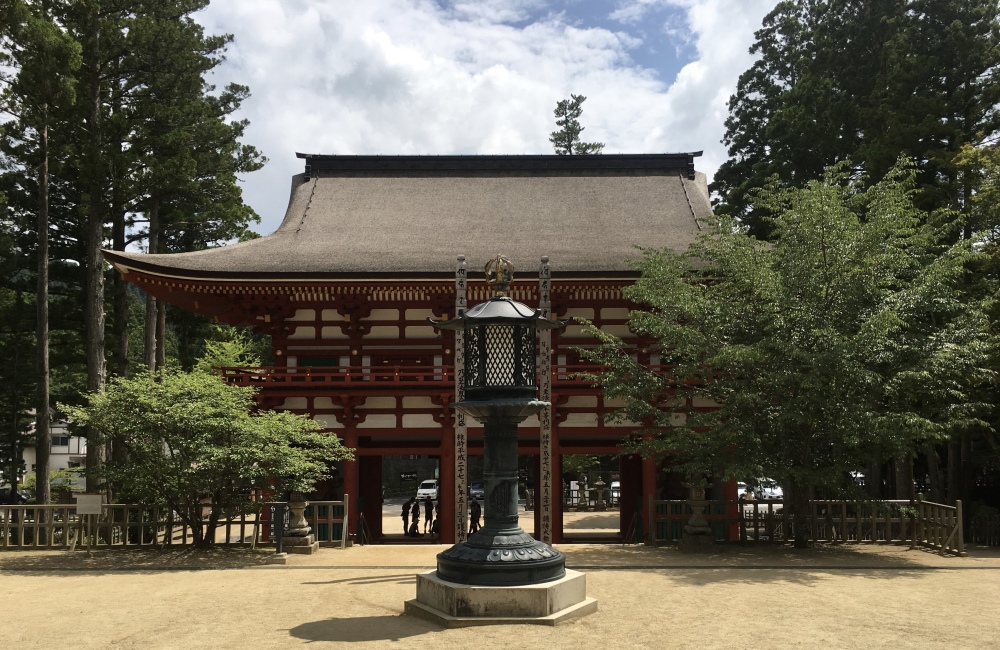
back side of Chumon

Details of the Kondo
The Kondo enshrines a statue of the Medicine Buddha that is not displayed, flanked by two large hanging mandalas, each with its own separate altar. Wall paintings show the eight offering bodhisattvas in the corners, and a large mural of the Buddha’s enlightenment is on the north side of the Kondo.

inside the Kondo

inside the Kondo
Inside the Kondo are wall paintings and murals.

murals inside the Kondo

murals

murals
The hexagonal shaped Rokkaku Kyozo was built in 1159 to house a complete copy of the Buddhist scriptures, written in gold ink. The building was lost in the fire of 1843, was rebuilt in 1884, and was lost again in the fire that destroyed the Kondo in 1926. The existing building was rebuilt in 1934. The 1884 building could be revolved, but only the present building’s outer rim can be revolved.
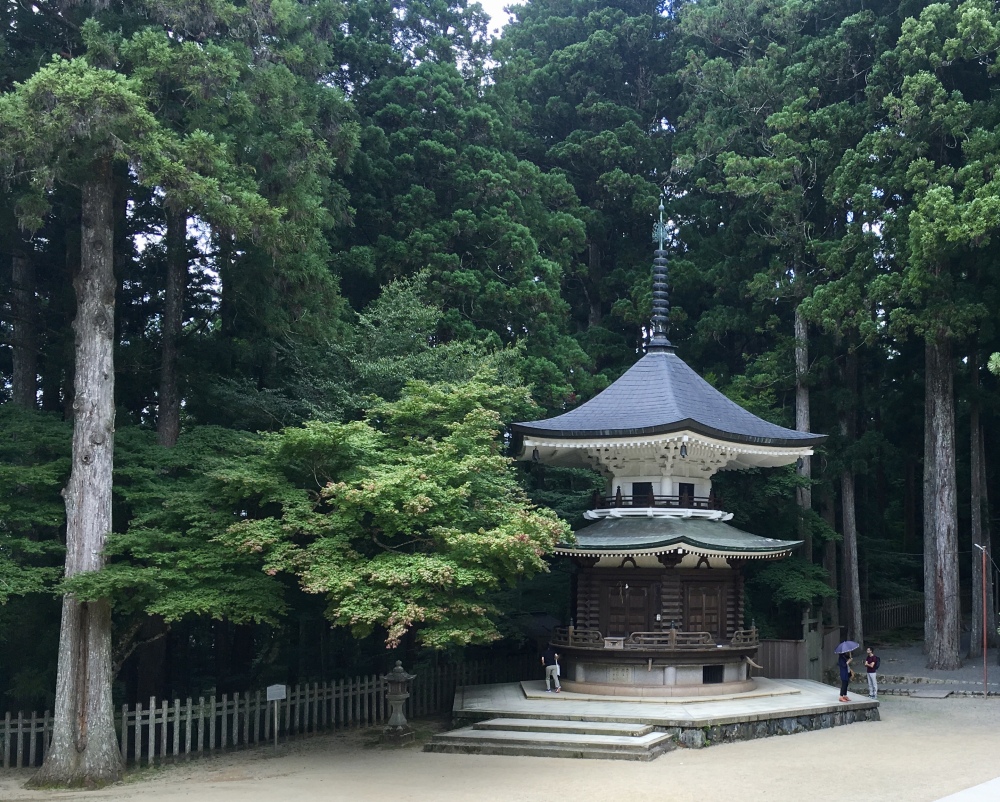
Rokkaku Kyozo
Konpon Daito, or the Great Fundamental Pagoda, is the tallest building in Kōyasan. After Kūkai was granted the use of Kōyasan by Emperor Saga in 816, he decided to build the first monastic complex entirely dedicated to the teaching practice of Esoteric Buddhism. He planned to construct two large two-story pagodas diagonally behind the Kondo in the eastern and western directions. Plans called for the Konpon Daito to be about 48.5 meters high, and because of its great size it was finally completed in 876, about 40 years after Kōbō-Daishi entered eternal meditation.

Konpon Daito, the stupa on the east side of the Kondo
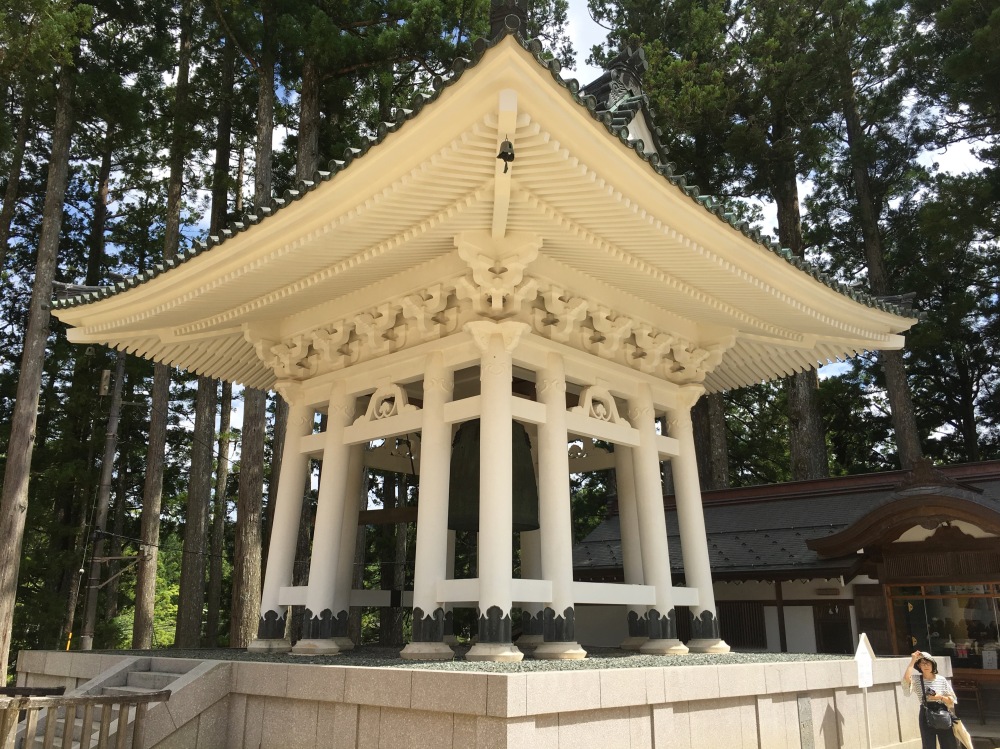
Shoro Belfry at Dai Garan
In later centuries the Konpon Daito was destroyed in fires caused by lightning strikes five times, and rebuilt each time. After the great fire of 1843, only the foundation stones remained. The existing building was rebuilt in 1937 of ferro-concrete with wooden overlays painted in vermilion because of the long history of fires. The building was last renovated in 1996.
The body of the pagoda is circular, with a square lower story with an attached pent roof and walls. The majestic Konpon Daito has the exact dimensions today was when it was first built. It enshrines a three-dimensional mandala, with large gilt wooden statues of Dainichi Myorai (Mahavairocana) of the Taizokai (Matrix Realm) surrounded by the Four Buddhas of the Kongokai (Diamond Realm), with the Sixteen Great Bodhisattvas painted on the sixteen pillars around them. Sadly no photography is permitted.
Konpon Daito is known as a symbol of Kōyasan.
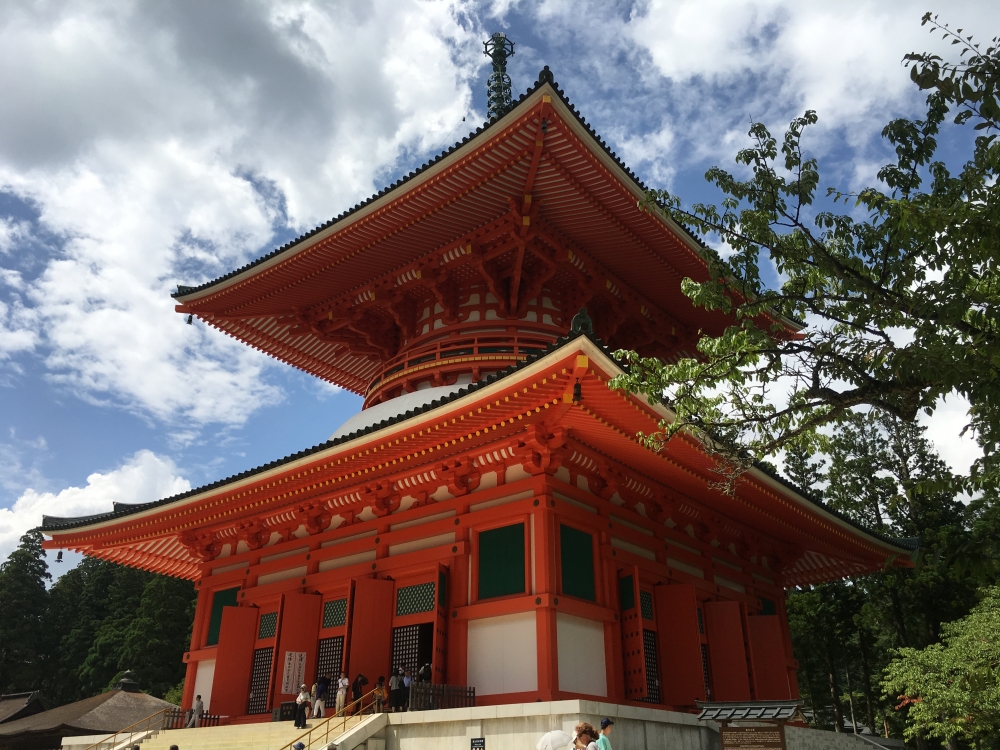
Konpon Daito

hall at Dai Garan
The Tōtō (Eastern Stupa) was completed in 1127 at the wish of the retired Emperor Shirakawa. The main deity enshrined is Vikiranosnisa, who is flanked by two wrathful deities. The pagoda that had been rebuilt in the Edo period burned to the ground in 1843, and the present building was reconstructed some 140 years later, in 1983.

Tōtō (Eastern Stupa)

Tōtō (Eastern Stupa)

Konpon Daito

Konpon Daito

bronze lantern and Kondo

a monk walks by the bronze lantern

hall at Dai Garan

pavilion at Dai Garan
Myō-jinja is home to Niu-myōjin, the royal mistress of Mount Kōya, and her son Kariba-myōjin, hunter guardian of the mountain’s forests. Most of Dai Garan is shaded by soaring black cedar trees.
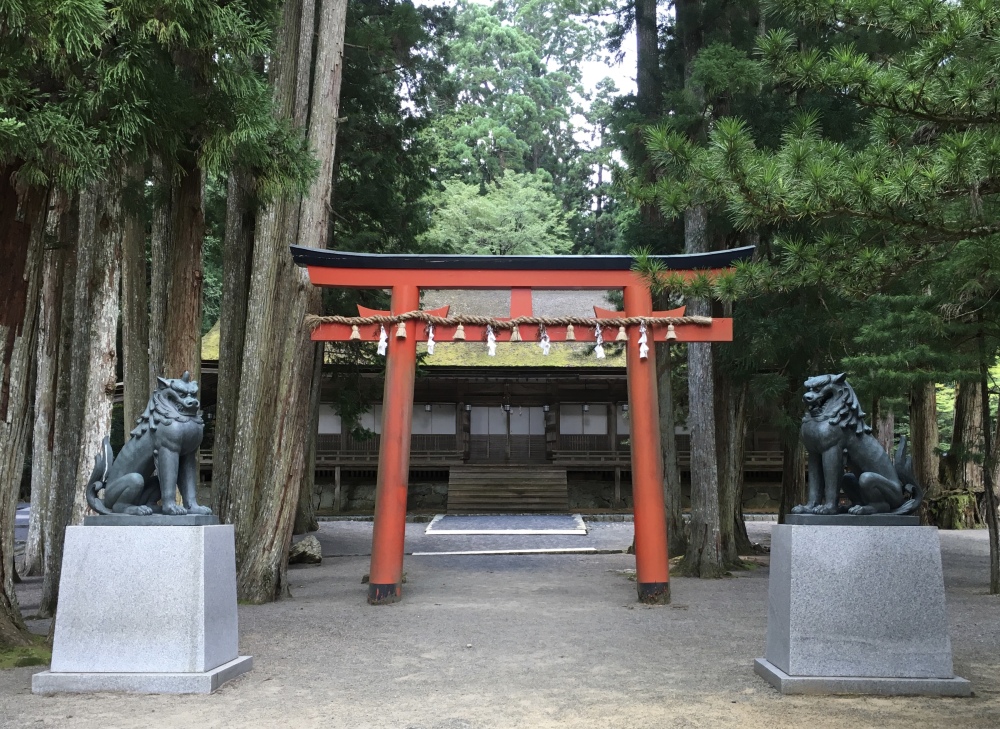
torii at entrance to Myō-jinja

Sannoin
The Saito, or Western Stupa, was originally built in 887, according to the instructions of Kōbō-Daishi. The present structure is the fifth reconstruction of the original building, and was built in 1834. The 36 pillars inside, plus the central pillar, represent the 37 deities of the Kongokai Mandala. Five Buddhas are enshrined here, with the central Buddha being Mahavairocana of the Kongokai surrounded by four Buddhas of the Taizokai. This demonstrates the teaching of the non-duality of the two mandalas.
I always love the older buildings that haven’t been rebuilt in ferro-concrete, like this one, although I know fires have destroyed these wooden buildings many times.

The Saito, or Western Stupa

The Saito, or Western Stupa

tree roots at Dai Garan

Konpon Daito
I wander over the red bridge to the islet in the center of the Lotus Pond.
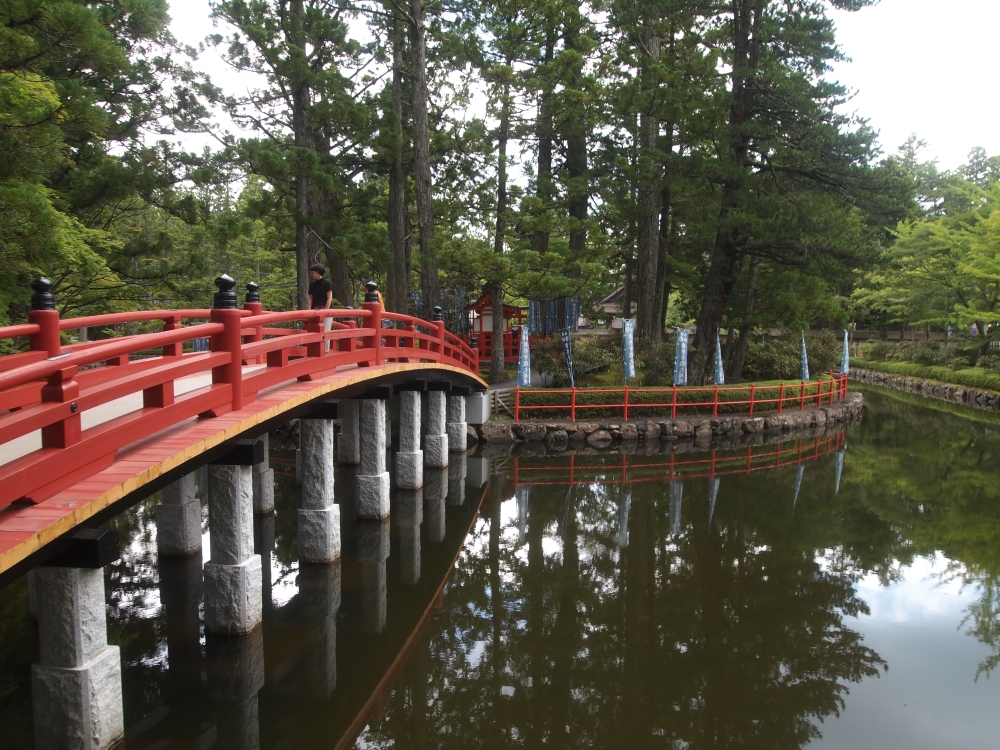
bridge over lotus pond
On the small islet is the Zennyo Ryuo Shrine, which enshrines a queen of the Naga, or dragon gods, believed to be most powerful in answering prayers relating to water and rain. This shrine originated when a monk prayed to the queen for rain during the drought of 1771.

Zennyo Ryuo Shrine
Situated at the west end of the basin of Koyasan, the Daimon, or Grand Gateway, is the western entrance to Koyasan from Kinokawa Valley and Aritagawa Valley. The gateway was reconstructed in 1705. It was recently repaired when the motorway opened.
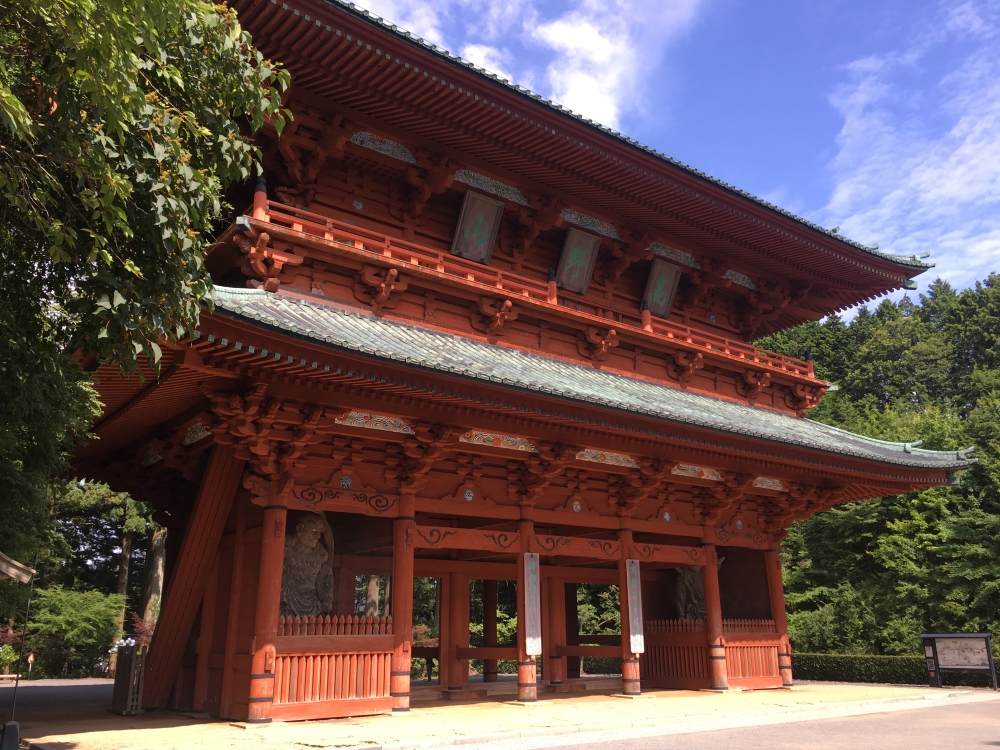
The Daimon, or large entrance gate, to Dai Garan
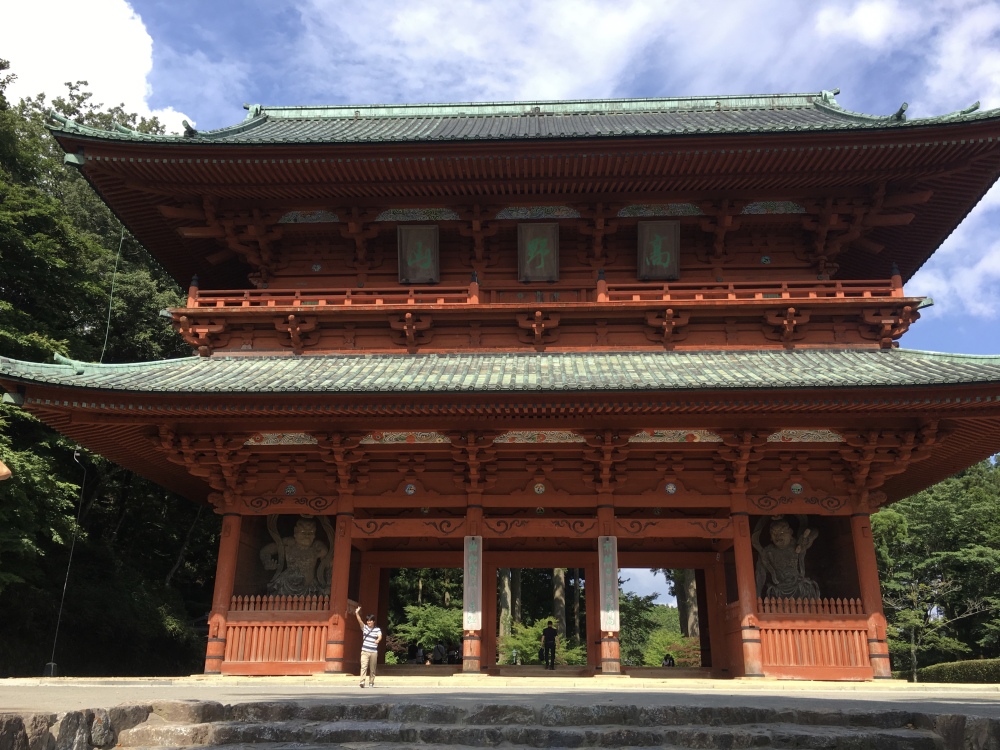
The Daimon
Inside the two main pillars of the gates are fierce looking Niō statues, guardians of this sacred area.

Niō statue

Niō statue
Temple Stay at Kongo Sanmai-in
After exploring all around Dai Garan, I walk back to Kongo Sanmai-in, where I can check in for the night.
Temple lodgings, or shukubō, are Buddhist temples that offer overnight accommodation to pilgrims and tourists. Open to both practitioners and non-practitioners, shukubō offer travelers a chance to experience the austere lifestyle of Buddhist monks while staying in historic temple buildings. In addition, visitors are usually invited to watch or participate in activities such as morning prayers or meditation (Japan-guide.com: Temple Lodgings). Of 117 temples on Koyasan, 52 of them offer lodging for overnight guests.
Kongo Sanmai-in is also considered a ryokan, or traditional Japanese inn. It has a bathhouse, multi-course dinners, communal spaces where guests can relax, and rooms with woven-straw flooring and futon mats.
The temple was built in the year 1223 by a widow named Hojo Masako, wife of the feudal lord Minamoto Yoritomo. She is said to have been the most powerful woman in Japanese history. Madam Masako became nun Nyojitsu after her husband died. She protected Kongo Sanmai-in Monastery by appointing a head priest, donating manors to the monastery, and encouraging Buddhist learning by establishing a school for learning. Yasumori, her vassal, supplied the priests with scriptures and commentaries on wooden block printing.
Kongo Sanmai-in is one of the most expensive places I stay during my time in Japan. It costs me 14,540 yen, or ~ $134. Dinner and breakfast are provided, and we are able to participate in the morning Buddhist ceremony. I have a small tatami-matted room to myself with a private bathroom. The whole experience is well worth the price.

Kongo Sanmai-in
After I settle into my air-conditioned room with private bath, I walk around to explore the grounds before dinner. I find the beautiful two-story Hato tower, dating to the 13th century.

stupa at Kongo Sanmaiin

stupa at Kongo Sanmaiin

a peek through the hydrangeas

stupa at Kongo Sanmaiin

on the grounds of Kongo Sanmaiin

Kongo Sanmaiin
The black cedar trees at Kongo Sanmai-in are ancient and majestic.

cedar trees at Kongo Sanmaiin

cedar trees at Kongo Sanmaiin
The Shisha Myojin Honden Shrine, a Shinto shrine housing the tutelary deity of Kongo Sanmai-in Temple, is inscribed with the date 1552.

Kongo Sanmaiin Temple Shisha Myojin Honden Shrine

Kongo Sanmaiin Temple Shisha Myojin Honden Shrine

path uphill
Like the stupa, this scripture repository building was also built in the Kamakura period. It is a rare example of the traditional azekurazukuri style, a simple wooden construction used in buildings like storehouses (kura), granaries, and other utilitarian structures. It is characterized by joined-log structures of triangular cross-section, and is commonly built of cypress timbers.

scripture repository

scripture repository

rakan at Kongo Sanmaiin

Kongo Sanmaiin

the grounds of Kongo Sanmaiin

Kongo Sanmaiin
I walk through the polished wooden halls of Kongo Sanmai-in and then through the interior courtyard garden. This is truly a comfortable and serene temple for a temple stay!

inside Kongo Sanmaiin

painted screen at Kongo Sanmaiin
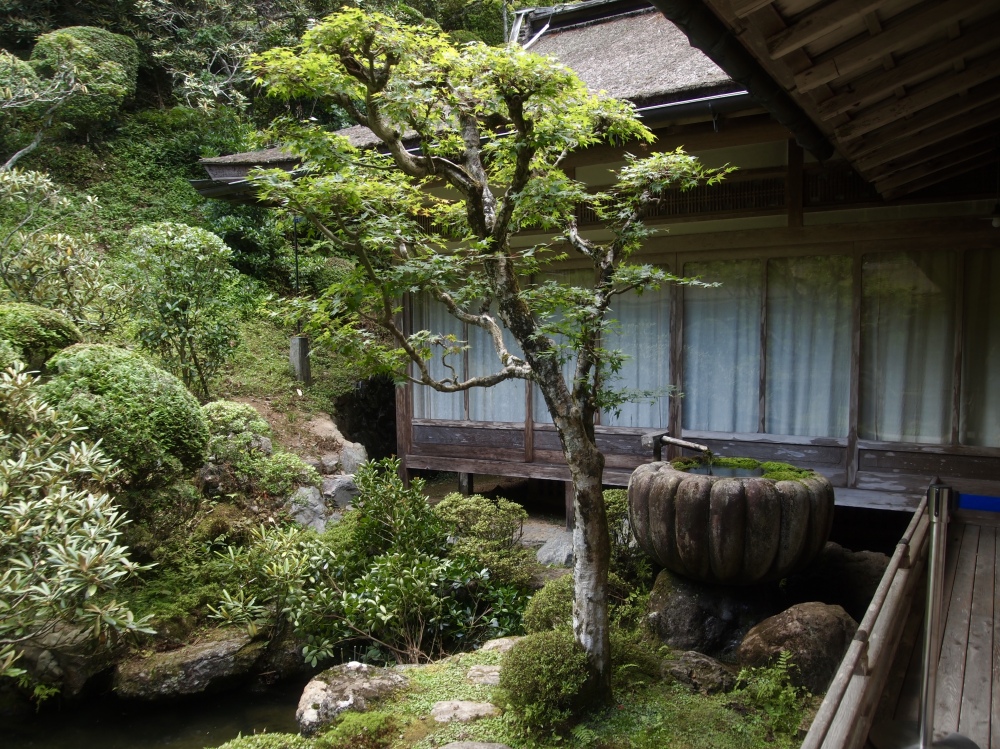
garden at Kongo Sanmaiin

garden at Kongo Sanmaiin

garden at Kongo Sanmaiin

garden at Kongo Sanmaiin

Kongo Sanmaiin

garden at Kongo Sanmaiin

another courtyard at Kongo Sanmaiin
I finish walking the grounds of Kongo Sanmai-in.

Kongo Sanmaiin
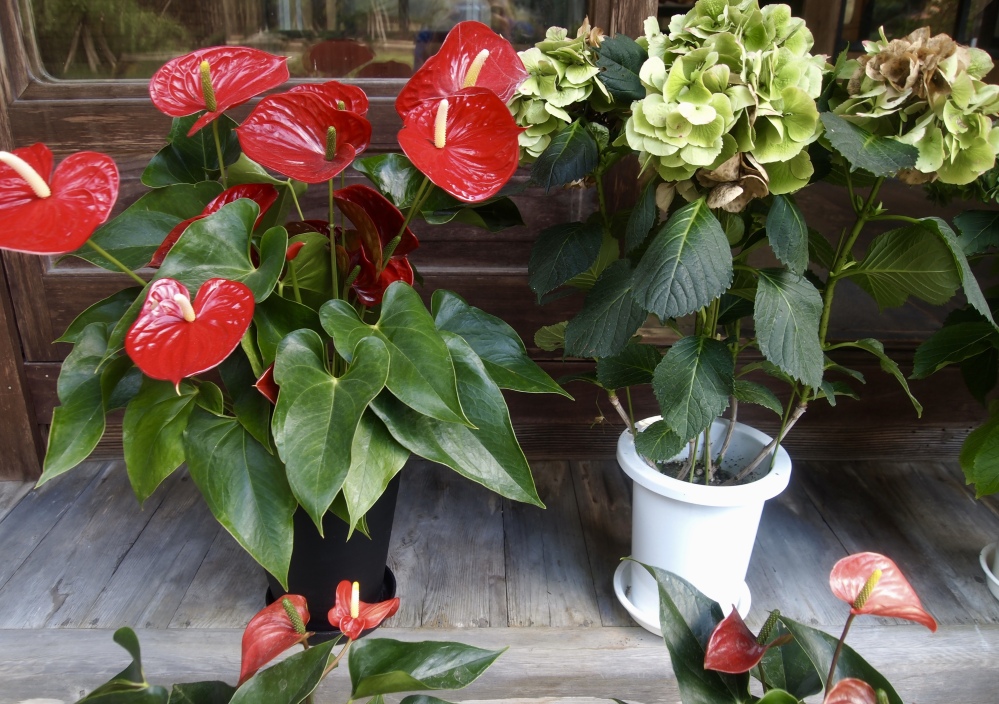
flower pots on the steps of Kongo Sanmaiin

pagoda at Kongo Sanmaiin

pagoda at Kongo Sanmaiin

pagoda at Kongo Sanmaiin
After my stroll around the grounds, I buy a beer from a vending machine and relax in my room while waiting for dinner. I had been wondering if alcoholic beverages would be served in a temple, so I’m pleasantly surprised to find several vending machines offering an array of choices.
At dinnertime, I join the other guests in a communal tatami matted room, where we’re served a Buddhist vegetarian meal or shojin-ryori. I enjoy tempura vegetables, miso soup, seaweed, beans, steamed vegetables, hot noodles, tofu, rice and mushrooms, all artistically presented. For dessert, watermelon and kiwi.
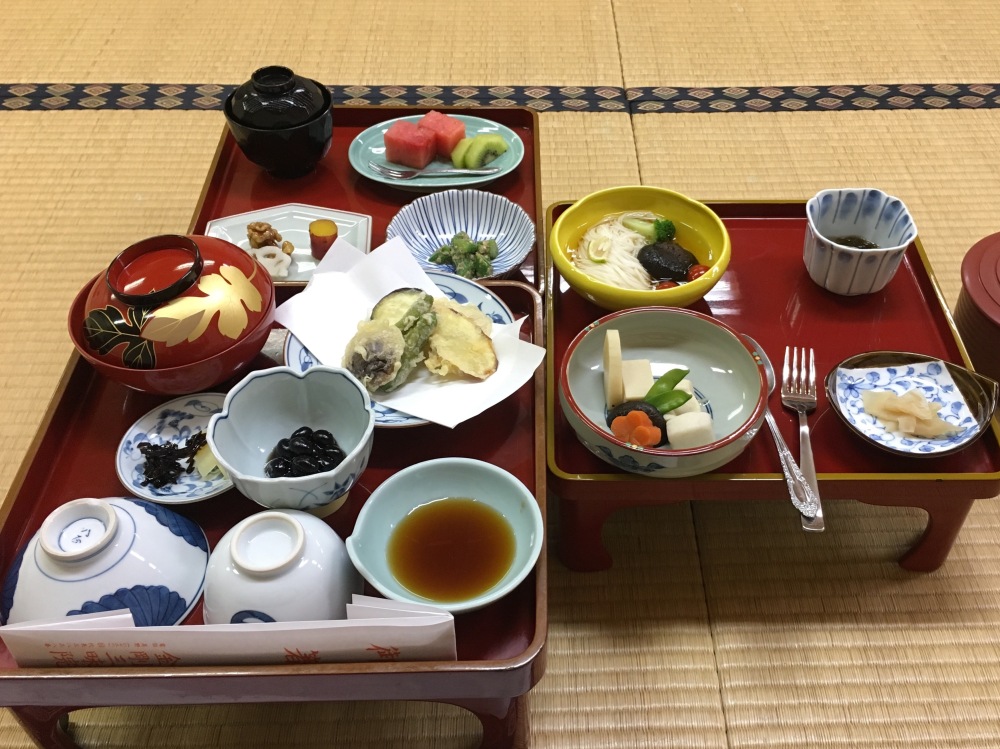
vegetarian meal at Kongo Sanmaiin
After dinner, I take an evening walk in Koyasan. The streets are pretty deserted at this hour.

temple in Koyasan

holy figure

holy figure

pagoda in Koyasan

elephant at the pagoda

lantern and deserted streets of Koyasan

hydrangeas on the walk

sunset at Koyasan
Later, I enjoy the communal onsen, or Japanese bath, and then go to sleep early. In the morning, I’ll awake before daybreak to attend the Buddhist Sunday morning ceremony.
Total steps today: 14,804 (6.27 miles).
Friday, August 4: After I finish eating the Kakinoha-zushi for lunch, I get on the bus to explore some of the Nara temples on the outskirts of the main temples.
Kasuga Taisha Shrine lies in a wooded area southeast of the main temples of Nara.

sake barrels at entrance to Kasuga Taisha Shrine

Nara’s deer
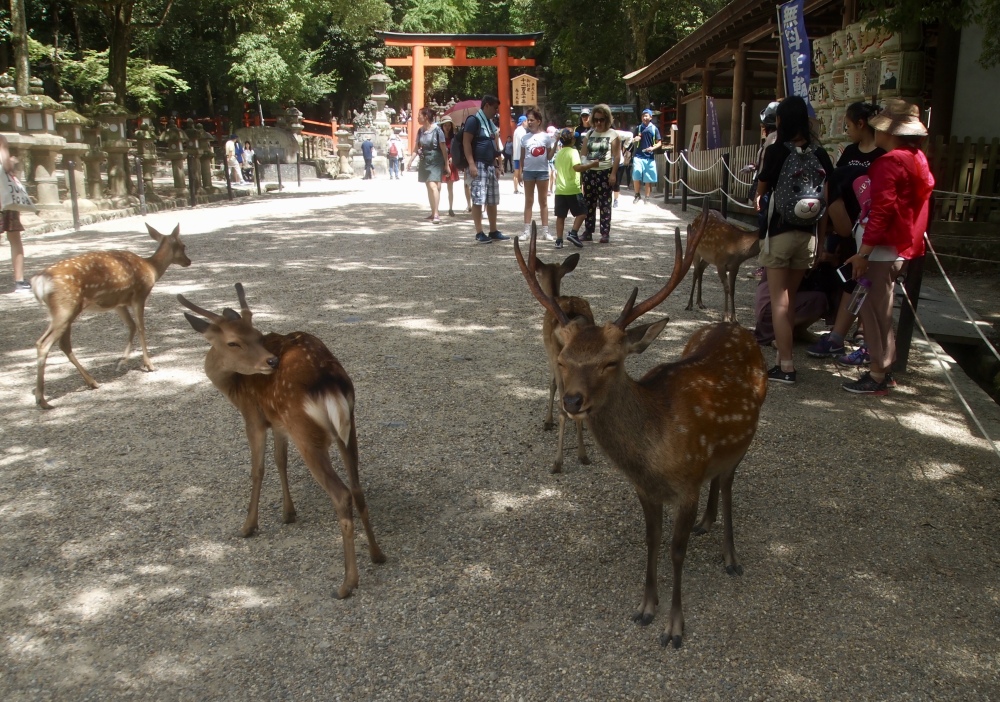
Nara’s deer
The paths to the shrine are lined with lanterns, and thousands more are in the shrine itself.

gate to Kasuga Taisha Shrine

lanterns and deer on the pathway to Kasuga Taisha Shrine

stone lanterns on the path to Kasuga Taisha Shrine

stone lanterns on the path to Kasuga Taisha Shrine

stone lanterns
Kasuga Taisha Shrine is a Shinto shrine established in 768 and rebuilt several times over the centuries. It is the shrine of the Fujiwara family, a family of powerful regents in Japan. The Fujiwara dominated the Japanese politics of Heian period (794–1185) by marrying Fujiwara daughters to emperors. In this way, the Fujiwara gained influence over the next emperor who would, according to family tradition of that time, be raised in the household of his mother’s side and owe loyalty to his grandfather, according to Wikipedia: Fujiwara clan.

Kasuga Taisha Shrine
The origin of Kasuga Taisha Shrine dates back 1,300 years, when Takemikazuchi-no-mikoto, Japan’s most powerful deity, was invited to the sacred peak of Mt. Mikasa, a beautiful mountain behind this site, after the transfer of the national capital to what is now Nara City. The shrine grounds were completed in 768 with four altars for the deity already mentioned, plus a deity working for nation-building and a deity of wisdom and fortune-telling, as well as a Sun Goddess revered in the Middle Ages.

lanterns approaching Kasuga Taisha Shrine
The shrine has always received respect from citizens of Japan, even after the capital moved to Kyoto. Some 3,000 lanterns, stone or bronze, standing or hanging, were donated by worshipers since the Heian period in a show of their ardent faith.

Kasuga Taisha Shrine
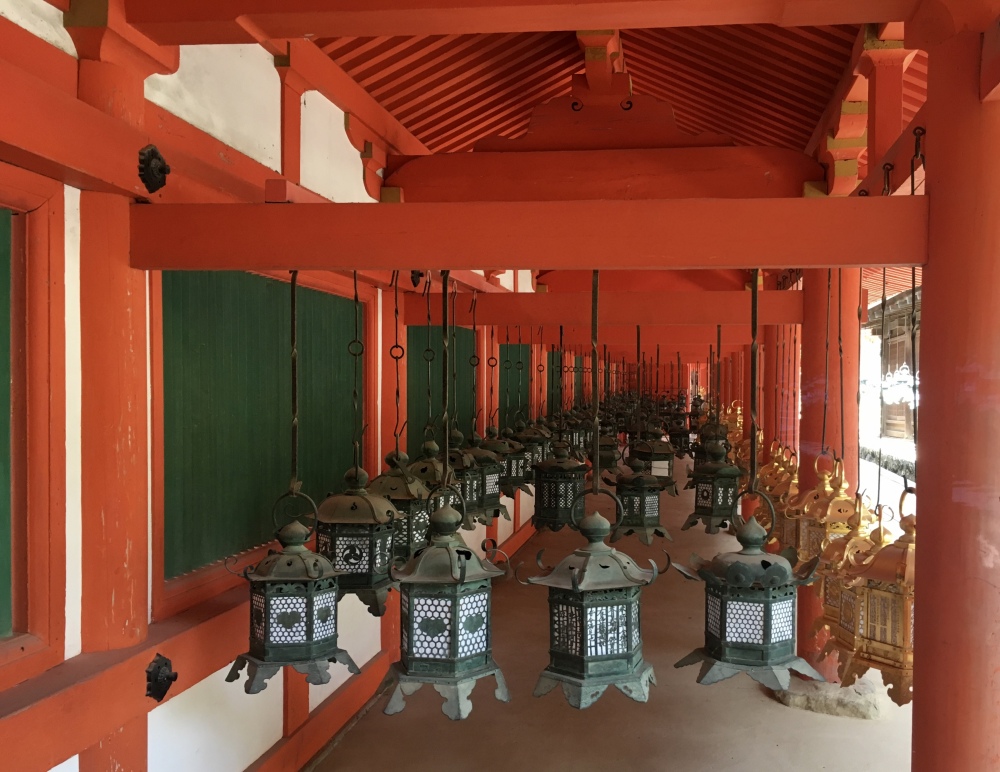
lanterns at Kasuga Taisha Shrine

ema at Kasuga Taisha Shrine

lanterns at Kasuga Taisha Shrine

ema at Kasuga Taisha Shrine

Kasuga Taisha Shrine

lanterns at Kasuga Taisha Shrine

lanterns at Kasuga Taisha Shrine

lanterns at Kasuga Taisha Shrine

lanterns at Kasuga Taisha Shrine
There seems to be no end to the lanterns at Kasuga Taisha Shrine.

stone lanterns at Kasuga Taisha Shrine

Kasuga Taisha Shrine

lanterns at Kasuga Taisha Shrine

lanterns at Kasuga Taisha Shrine

lanterns at Kasuga Taisha Shrine

lanterns at Kasuga Taisha Shrine

Kasuga Taisha Shrine

lanterns at Kasuga Taisha Shrine
There is even a dark room with lit lanterns at the shrine.

lanterns at Kasuga Taisha Shrine

lanterns

lanterns

lanterns

lanterns
The ema at Kasuga Taisha Shrine show the lanterns and the deer encountered all along the way.

ema at Kasuga Taisha Shrine
With numerous rituals, the is a place of prayers for peace and prosperity for everyone on earth.
The Nagi (podocarpus nagi) pure forest in Kasuga Taisha was designated as a National Monument in 1923. It’s known for its spread of upright, dense evergreens with pointed, leathery, dark green leaves arranged on stiff, symmetrical branches. The tree works very well as a screen, hedge, strong accent plant, or framing tree.
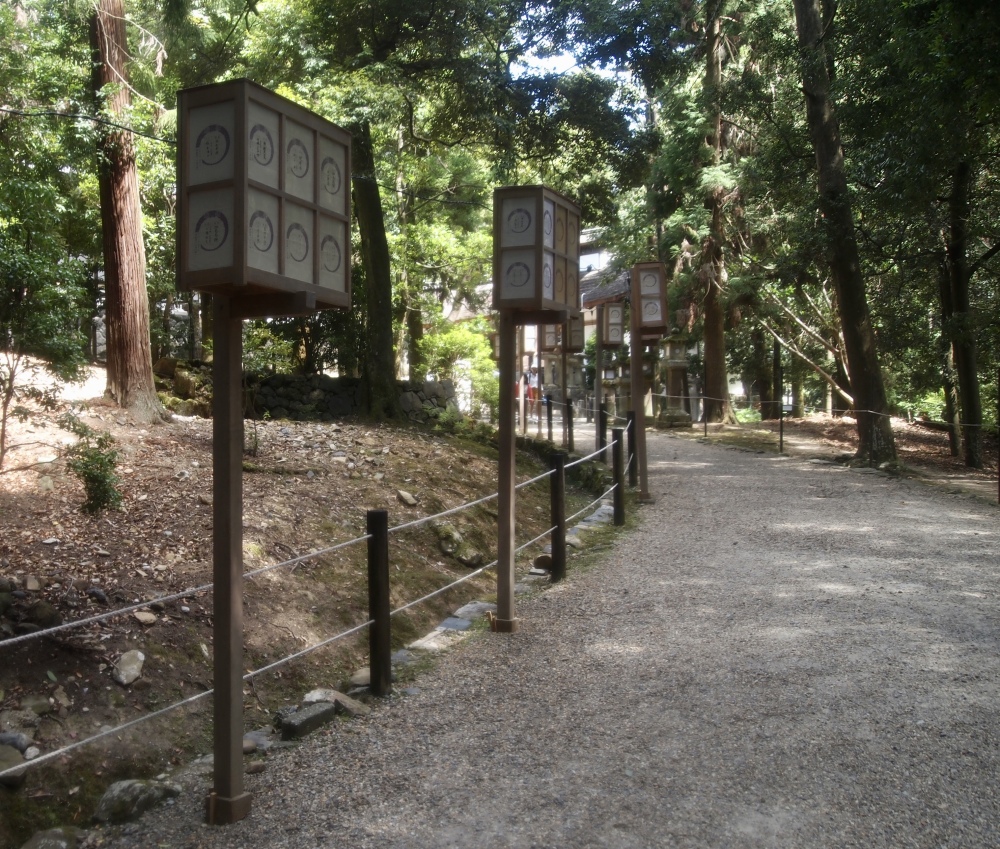
Nagi (pure) forest in Kasuga Taisha
Wakamiya Jinja Shrine is an altar dedicated to the Deity of Wakamiya. The annual festival of Kasuga-Wakamiya-Onmatsuri has been held from December 15-18 continually since 1136. These religious rites, designated as Significant Intangible Folk Cultural Assets by the central government, include prayers for reducing the spread of epidemics or famines, as well as a gorgeous procession of people in traditional costumes.

Wakamiya Jinja Shrine

wishes at Wakamiya Jinja Shrine

Wakamiya Jinja Shrine

Wakamiya Jinja Shrine

Wakamiya Jinja Shrine

Nagi (pure) forest in Kasuga Taisha

ema at Wakamiya Jinja Shrine

ema at Wakamiya Jinja Shrine
Wakamiya Jinja Shrine is also surrounded by moss-covered stone lanterns.

moss-covered stone lanterns
After visiting these two shrines, I take another bus to the famous Kohfukuji Temple. The original structure was built at the behest of the emperor Shōmu in 726 to speed the recovery of the ailing Empress Genshō.
This used to be the Fujiwara family temple. The temple was established in Nara at the same time as the capital was established here in 710. At the height of Fujiwara power, it is said the temple consisted of between 150 and 175 buildings. Fires and destruction as a result of power struggles have left only a dozen standing.
Today a couple of buildings of great historic value remain, including a five-story pagoda and a three-story pagoda.

Kohfukuji Temple
The “Eastern Golden Hall” or Tokondo, a 15th century building north of the Five-Story Pagoda, has a number of Buddhist statues including a large image of Yakushi Nyorai flanked by three Bodhisattva, the Four Heavenly Kings and the Twelve Heavenly Generals, plus a beautiful seated image of Yuima Koji (the Indian Buddhist sage Vimalakirti) (Japan Visitor). Sadly, no photography is allowed and I’m unable to find any postcards with the images.
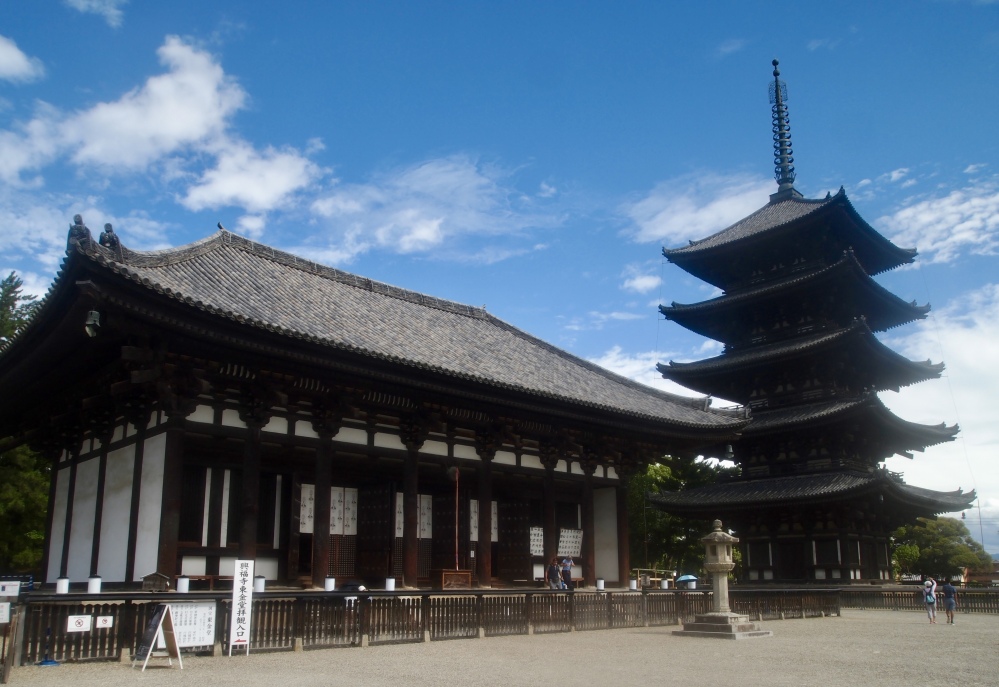
Kohfukuji Temple

Kohfukuji Temple
At 50 meters, the five-story pagoda is Japan’s second tallest, just seven meters shorter than the five-story pagoda at Kyoto’s Toji Temple. Kofukuji’s pagoda is both a landmark and symbol of Nara. It was first built in 730. The pagoda had burnt down no less than five times before the 15th century. It was most recently rebuilt in 1426.

Five Story Pagoda at Kohfukuji Temple
The Three-Story Pagoda dates from the early 12th century and houses some important Buddhist paintings.

Three-story Pagoda

inside the Three-Story Pagoda

Five Story Pagoda

Kohfukuji Temple

Kohfukuji Temple

Kohfukuji Temple

deer art

Three-Story Pagoda

water pavilion at Kohfukuji Temple

ema at Kohfukuji Temple

water pavilion

Kohfukuji Temple
I use the bathroom on the grounds of Kohfukuji Temple, where I find these funny signs.

bathroom signs

bathroom signs at Kohfukuji Temple
After visiting Kohfukuji Temple, I make my way back through the congregations of deer on the way to my hotel.

Nara’s deer

Nara’s deer

Nara’s deer
I take a shower at the hotel before going out for dinner because I’m soaked in sweat. This heat and humidity in Japan is killing me!
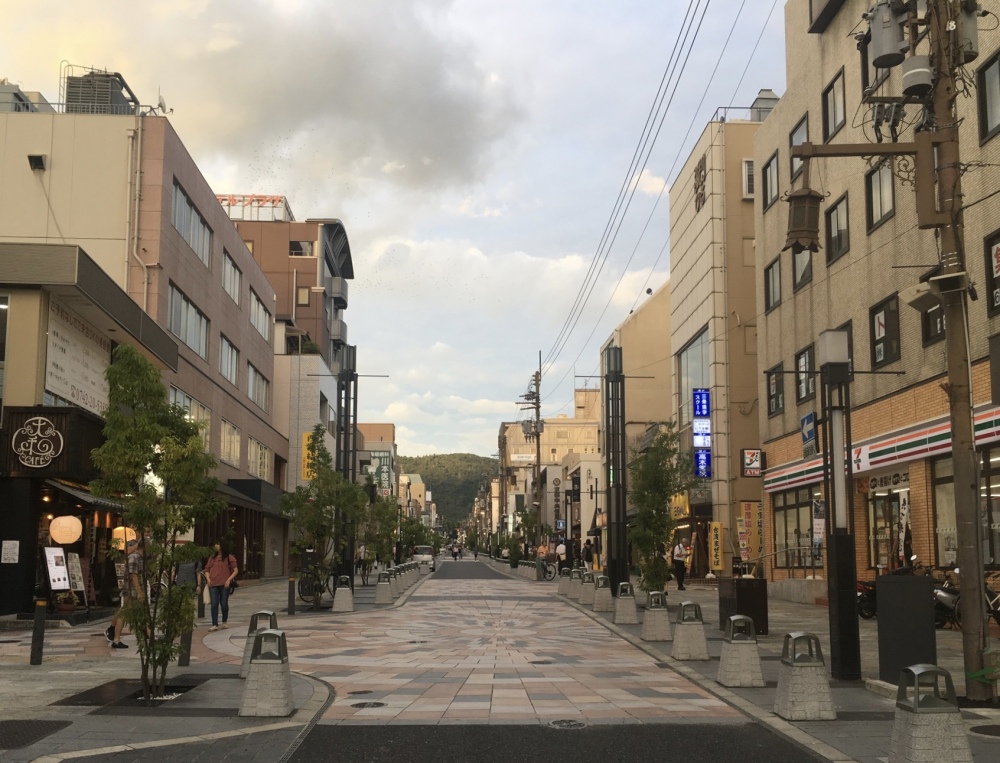
downtown Nara
I head to Manna Indian Restaurant, luckily air-conditioned.

Menu for Manna Indian Restaurant

Manna Indian Restaurant
I enjoy Gobi Masala and a huge paan, accompanied by a cold beer.

Gobi Masala
I walk back under gorgeous skies to my hotel.

Nara at sunset

Nara at night

Nara

bicycles in Nara

signs in Nara

vendor in Nara

downtown Nara

the train station

heading to the train station
Back at the hotel, I have a 30-minute massage followed by a great night’s sleep. Tomorrow morning, I’ll head to Koyasan, which will be quite a convoluted trip.
Steps today: 18,075 (7.66 miles).
Friday, August 4: This morning, my second day in Nara, I take bus #70 for 20 minutes to two temples south of Nara proper: Toshodaiji Temple and Yakushiji Temple.
Toshodaiji Temple is the headquarters of the Ritsu Sect of Buddhism. It was established in 759 when the Chinese priest Ganjin Wajo (688 to 763), a high Buddhist priest of the Tang Dynasty, opened what was originally called Toritsushodai-ji Temple to help people learn the Buddhist precepts. He was invited by Japanese Buddhists studying in China to teach the Imperial Court about Buddhism. In 753, overcoming the hardship of losing his eyesight, he arrived in Japan during his sixth attempt to cross the ocean.

Toshodaiji Temple
The Kondo (Golden Hall or Main Hall) houses the principal seated Rushana Buddha, the standing Yakushi Tathagata statue and the standing Thousand Armed Avalokiteshwara National Treasure.

Kondo (Golden Hall or Main Hall) at Toshodaiji Temple
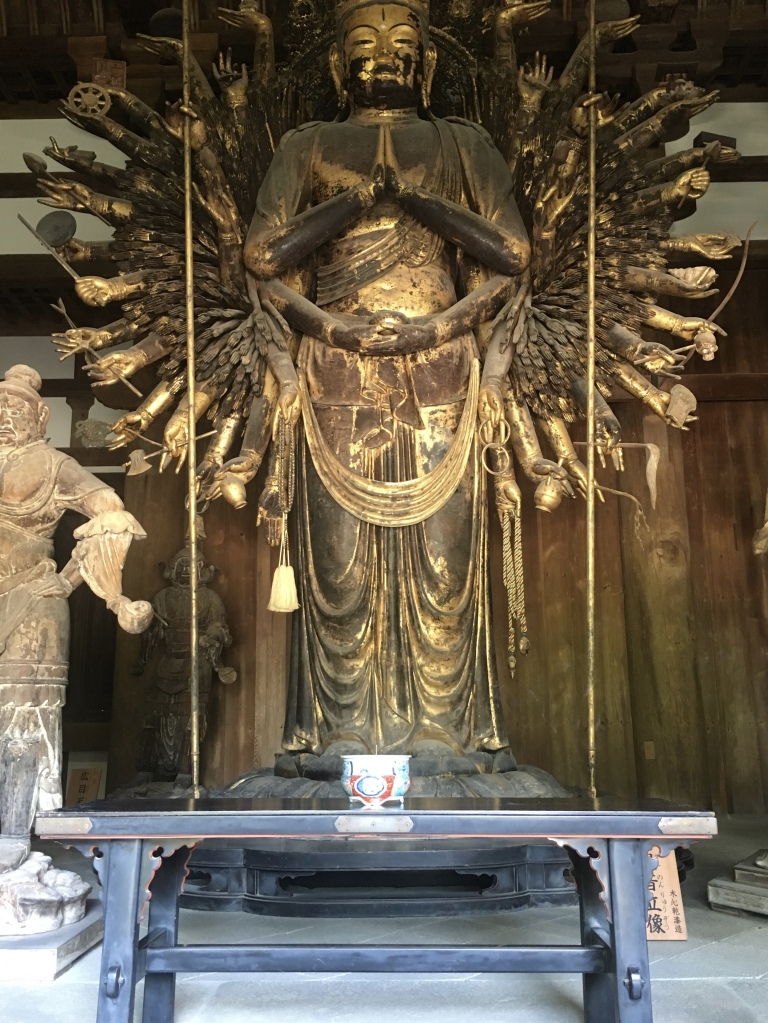
Thousand Armed Avalokiteshwara National Treasure
Photography isn’t allowed inside the halls, but below are three postcards of the Buddhas at Toshodaiji Temple. Click on any image for a full-sized slide show.

Thousand Armed Avalokiteshwara National Treasure

Rushana Buddha

Toshodai-ji
The Kondo, from the 8th century (Nara era) at Toshodaiji Temple is simple, but elegant, as are most Japanese temples.

Kondo (Golden Hall or Main Hall)
The Koro (Multi-storied building) from the 13th century (Kamakura era) is also called “Shariden (reliquary hall) because Buddha’s ashes brought by Ganjin Wajo were enshrined here. In the Zushi (miniature shrine) within the building, the Kinki (golden tortoise) is enshrined. This is also a National Treasure.

Toshodaiji Temple
The Rye-do (Chapel), from the 13th century, was originally the sleeping quarters for monks and is an important cultural property.

Rye-do (Chapel)
The Kodo (Lecture Hall) is from the Nara era. It is a building removed from the Heijo Palace and reconstructed, where the principal seated Maitreya Tathagata statue (important cultural property), the standing Jikoku-ten statue, and the standing Zojo-ten statue are enshrined. It’s another national treasure. I don’t have any pictures of these magnificent statues, sadly, as photography is not allowed.

Kodo (Lecture Hall)

Toshodaiji Temple

Toshodaiji Temple

Toshodaiji Temple

Toshodaiji Temple
A path leads through Toshodaiji Temple to another leafy path.

walkway at Toshodaiji Temple
It’s a welcome relief to find some shade on this hot and sultry day.

path at Toshodaiji Temple
At the end of the path, I find a lovely moss garden with dapples and shadows.

moss garden at Toshodaiji Temple
At the far end of the moss garden is the Kaizan Gubyo, or the Grave of Ganjin, the Founder of Toshodaiji Temple.

Grave of Ganjin, the Founder of Toshodaiji Temple

moss garden at Toshodaiji Temple

moss garden at Toshodaiji Temple

moss garden at Toshodaiji Temple

moss garden at Toshodaiji Temple

lantern at Toshodaiji Temple

moss garden at Toshodaiji Temple

moss garden at Toshodaiji Temple
Toshodaiji Temple is far from Nara proper and its crowds, so it is quite serene here.

Toshodaiji Temple

the Kondo of Toshodaiji Temple
On the way to the Kaidan (ordination platform), a garden of lotus blossoms beckons.

Toshodaiji Temple

gate to Kaidan (ordination platform)

Kaidan (ordination platform)

lotus at Toshodaiji Temple

lotus at Toshodaiji Temple
Toshodaiji Temple has a few beautiful lotus blossoms, even in the heat of the day.

lotus at Toshodaiji Temple

lotus at Toshodaiji Temple

bell at Toshodaiji Temple

Toshodaiji Temple
In looking at my map of these two temples, which are close to each other, I decide instead of taking the bus, I’ll walk to Yakushiji Temple. Though the map says it’s only a half kilometer, it seems longer than that, especially in this heat.
Yakushiji is the headquarters of the Hosso sect of Japanese Buddhism. The actual founder of the Hosso sect is Jion Daishi, but much of the Hosso Sect descends from the “Yugayuishiki” (Yogacara) teachings of Hsuan Tsang (600-664), a famous priest in the T’ang era in China. He studied Buddhism for 17 years in India. After returning to China, he translated 1,335 volumes of important Buddhist writings, and then taught them as well.
Yakushiji was planned around 680 by Emperor Temmu to pray for the recovery of his Empress from a serious illness. During the long construction period, Temmu died and his Empress acceded to the throne and was called Jito. The dedication ceremony for enshrining the chief Buddha, Yakushi Nyorai (the Buddha of Healing or Medicine Buddha) was held in 697. The entire compound was completed in 698 in the south part of Nara, in the Fujiwara Capital. Ten years later, the Capital was moved to the north of Nara (in 710) and Yakushiji was moved to its present site in 718. It is now a UNESCO World Heritage Site.

Yakushiji Temple
Yakushiji was burnt down and destroyed by fires, wars, or natural disasters several times. The most damage was caused by the civil war in 1528. Today only the Yakushiji Triad in the Kondo, the Sho-Kannon in the Toindo and the East Pagoda recall the grandeur of its original features.
Today, sadly, some major parts of the compound are under construction.
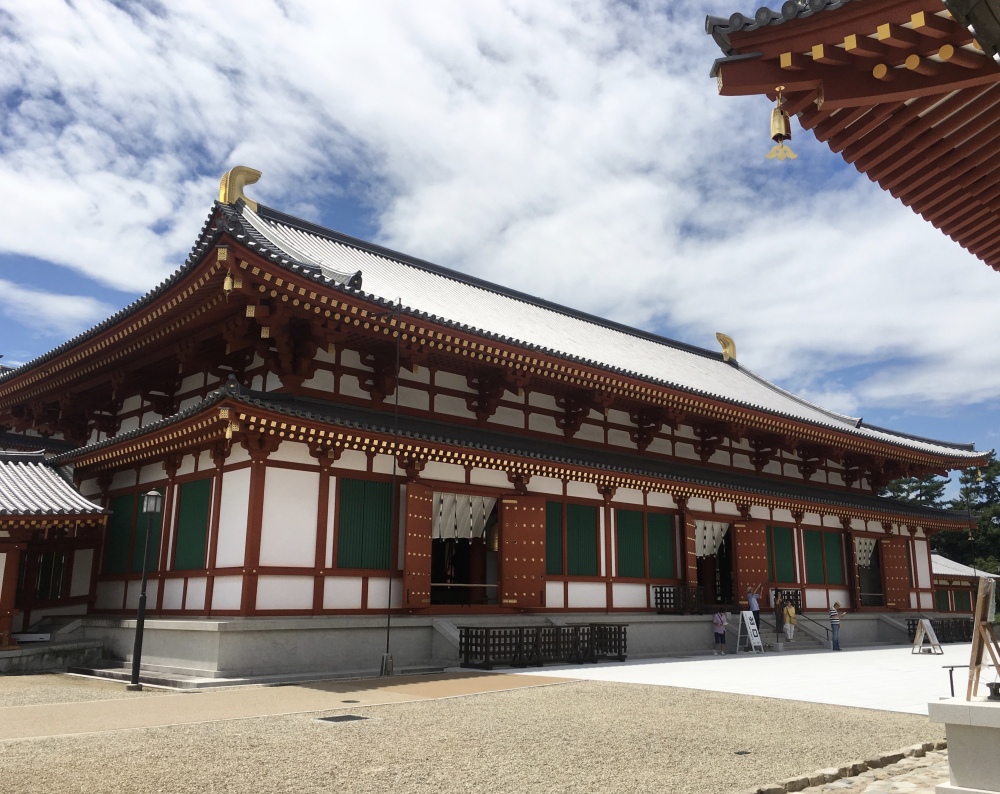
Kodo, or Great Lecture Hall, at Yakushiji Temple

Kondo, or Golden Hall, at Yakushiji Temple
Sadly, because no photography is allowed of the famous Buddha statues, I purchase a couple of postcards of the images. Neither the postcards, nor any photos, could do them justice, as they are imposing and sit within the beautiful Kondo, or Golden Hall. Between the Buddha statues at Toshodaiji Temple and here, at Yakushiji Temple, I’m in awe. These are truly magnificent pieces of art.
Postcards from Yakushiji Temple show the famous Yakushi Triad: the Yakushi Nyorai flanked by the Bodhisattvas of the sun and moon. These are arguably some of the most beautiful statues in all of Japan.
The postcard on the left shows Yakushi Nyorai, a bronze statue (225 cm, or 7.4 feet tall) that is a National Treasure from the Hakuho Period (645-710); he is the Buddha of Healing and the Lord of the Emerald Pure Land in the East, who vowed to cure diseases of the mind and body. He was already popular in Japan before the 7th century. He is also worshiped in order to achieve longevity. Though Yakushi Nyorai usually has a medicine pot in his left hand, this one does not.
The postcard to the right shows one of two Bodhisattvas – Nikko Bosatsu, who attends Yakushi Nyorai on the right side. Gakko Bosatsu (not pictured), stands on the left side. Both are about 320 cm, or 10.5 feet tall. Nikko means the sunlight and Gakko means the moonlight. They are impressive because of their twisted bodies, their graceful features, and the free flow of their robes.
Yakushi Nyorai is similar to the doctor of mind and body and Nikko and Gakko Bosatsu are the nurses.

Yakushi Nyorai

Nikko Bosatsu (National Treasure) – Yakushiji Temple
“Pagoda” means grave in Pali, the ancient Indian language, and it was called “stupa” in Sanskrit. Pagoda means the grave of Buddha. Yakushiji is the first temple that had twin pagodas on its grounds.
Unfortunately, the original West Pagoda at Yakushiji Temple was burned down in 1528. After the reconstruction of the Kondo, the West Pagoda was rebuilt in 1980. The East Pagoda (not pictured), which miraculously survived the fire that destroyed Yakushiji in 1528, is the only surviving architecture of the Hakuho Period in Japan. Unfortunately for me, the East Pagoda is under renovation and is covered in scaffolding today.
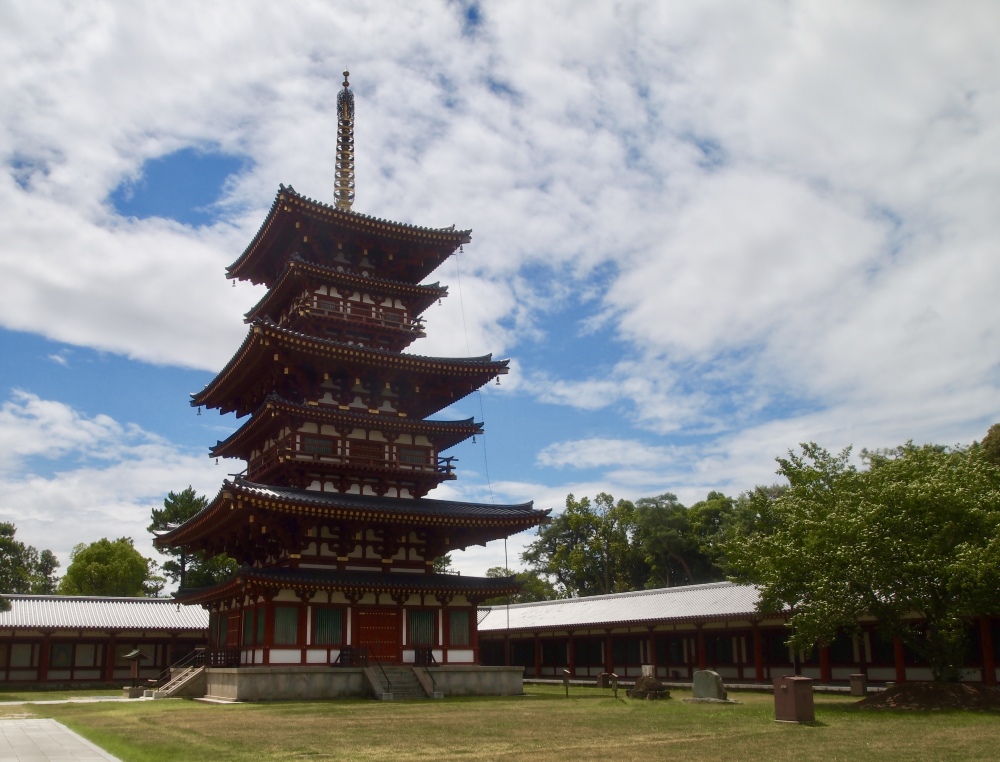
West Pagoda at Yakushiji Temple

Buddha image at Yakushiji Temple

West Pagoda at Yakushiji Temple

Golden Hall at Yakushiji Temple
The Middle Gate stands between the South Gate and the Kondo, or Golden Hall. You can see a hot wind is blowing.

Middle Gate at Yakushiji Temple

Guardian of the Middle Gate

Guardian of the Middle Gate
The Golden Hall at Yakushiji Temple is truly magnificent, especially with those spectacular Buddha statues inside.

Golden Hall at Yakushiji Temple
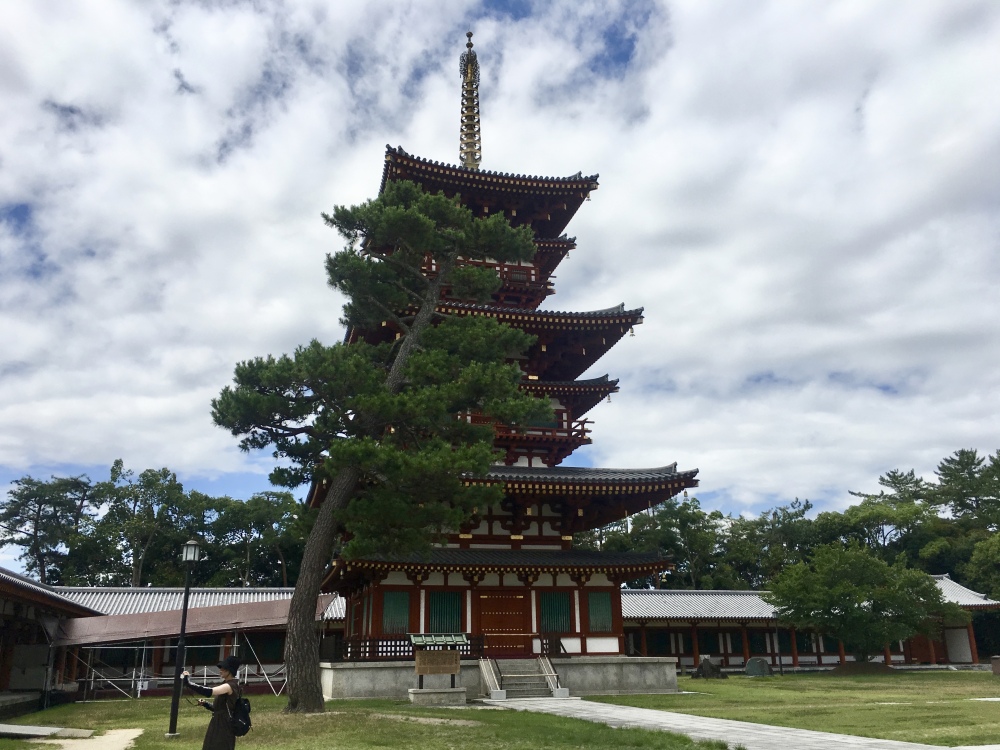
West Pagoda
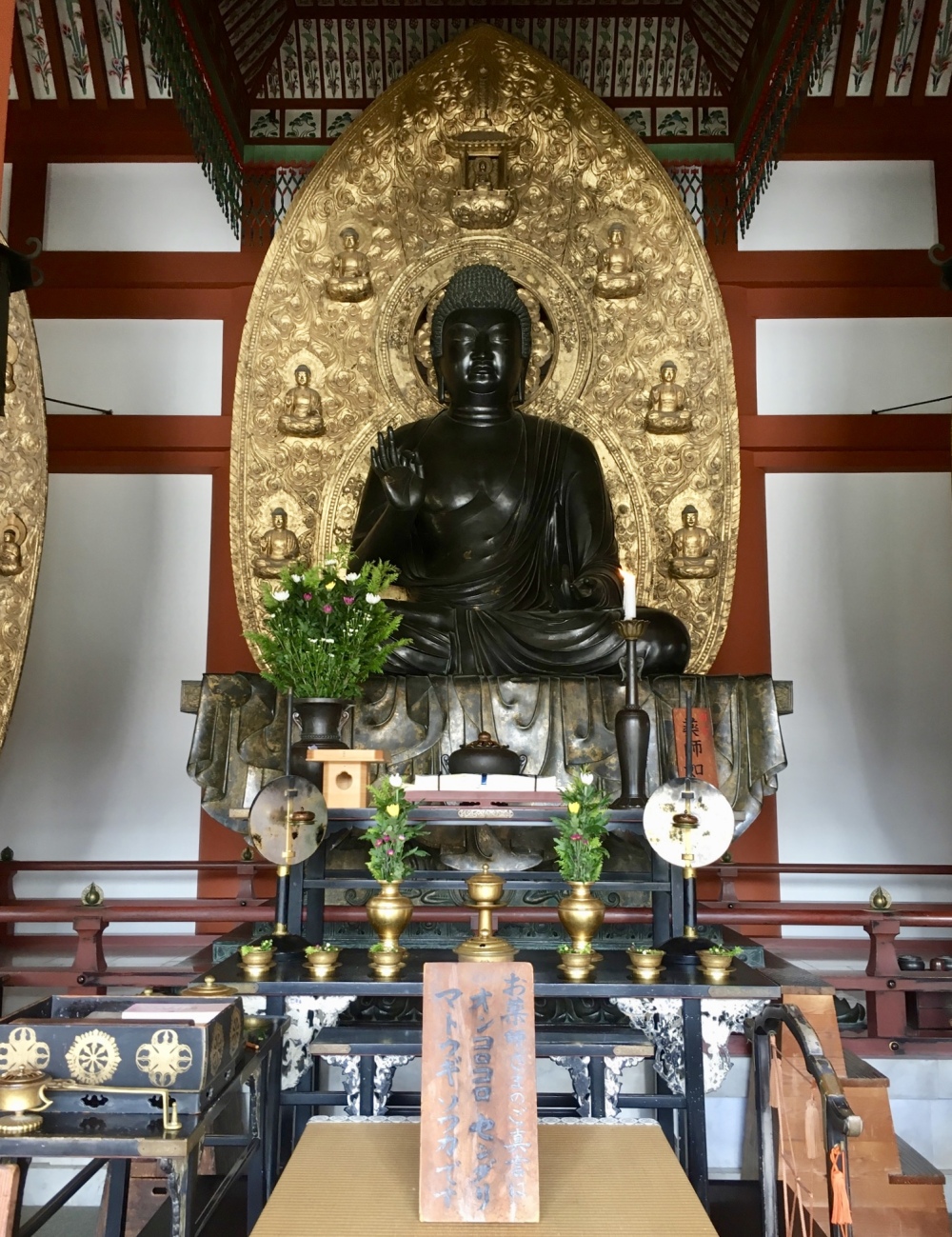
Buddha at Yakushiji Temple
After my visit to both of these fabulous temples and their resplendent Buddha images, I catch bus #70 to return to Nara. Back at the train and bus station, I search inside a big supermarket for kakinoha-zushi, which translates as “persimmon leaf sushi.” The Nara region is famous for this delicacy. I am able to show the name in Japanese to one of the supermarket employees, who points out the package.
Kakinoha is individual pieces of sushi wrapped in persimmon leaf, shown below. You’re not supposed to eat the persimmon leaves. I sit outside on the front stoop of the supermarket with a bunch of other people enjoying this treat, although it’s a little awkward opening up the persimmon leaves and eating them while holding them on my lap.

kaki-no-ha

kaki-no-ha

kaki-no-ha
After I finish eating, I’m on my way by another bus to Kasuga Taisha Shrine, Wakamiya Jinja Shrine, and Kofuku-ji. 🙂
Thursday, August 3: This morning, I take the 10:17 a.m. Shinkansen from Hiroshima to Kyoto, arriving at 11:54 a.m. There, I get on the Nara Line to Nara Station (12:03-12:48). On the train, I sit beside a 34-year-old guy named Zachary who teaches grammar and literature to middle school students at a private school in L.A. He’s going to Nagasaki to make some kind of presentation for the peace ceremony on August 9. We chat for the entire 45 minutes; in Nara, I disembark from the train and am off to find the Hotel Nikko Nara.
After dropping my bags at my hotel, which is a nice one right next to the train station, I stop to eat tempura and rice at a restaurant at the station. There I meet a friendly and talkative Japanese housewife named Hiromi who asks if she can join me. She tells me she’s from Yokohama and has come down here for one day to see two things, one museum in Kyoto and one in Nara. She plans to return home late tonight. She herself has no children but she asks endless questions about my teaching job and says she is embarrassed on behalf of all Japanese people for my misbehaving “I” class.
After lunch, I hop on Bus #2 at Nara Station and I hear a loud: “Cathy!!” I look around to find Christine from Luxembourg, who I met in Nikko last weekend. When we talked about our travel plans in Nikko, I knew that the only place we might intersect was in Nara, but never in a million years did I actually expect to run into her here. What a small world it is sometimes!
She is on her way to Yoshiki-en, a garden that is free for foreign tourists. I am on my way to the Great Buddha, but as the garden is on my way, we explore the garden together. It is sweltering and humid, but we wander around, enjoying the shade offered by little pavilions along the way. There are three unique gardens within Yoshiki-en: a Pond Garden, a Moss Garden and a Tea Ceremony Garden. The Moss Garden has a detached thatch-roof tea house. In the Pond Garden, slopes and curves of the land remaining from the Edo period (17th-19th centuries) blend with the buildings. The garden is a suitable environment for hair moss (Polytrichum), so the whole area is covered with it. The garden, originally the home of the high priest of Tōdai-ji, was laid out in 1918.

Yoshiki-en

Yoshiki-en

Yoshiki-en
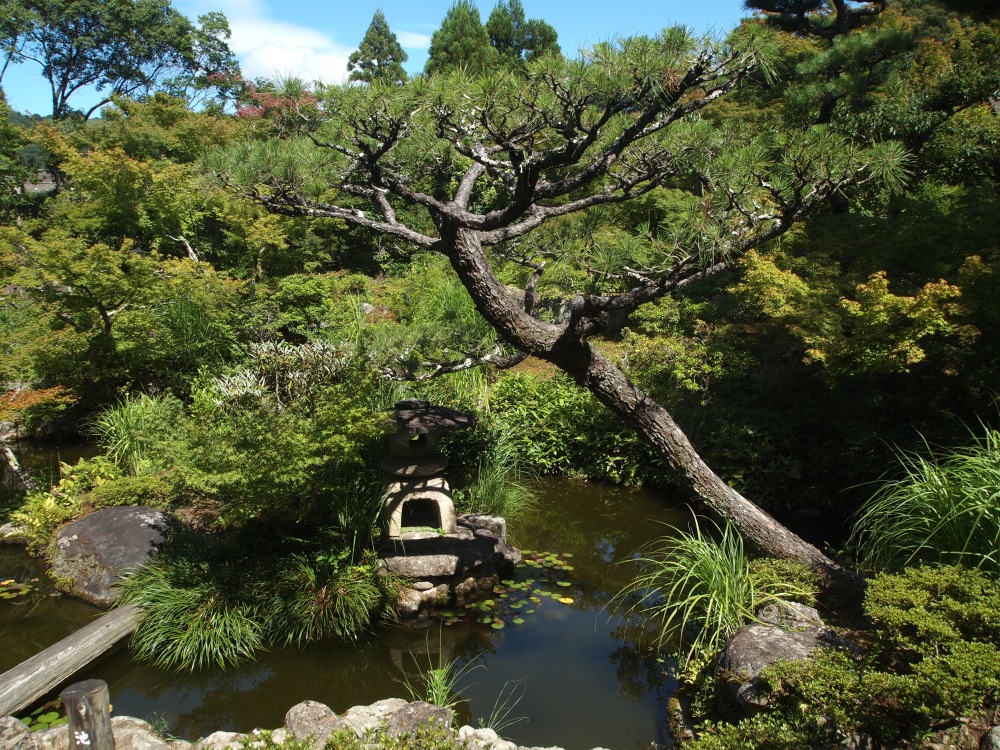
Yoshiki-en
Click on any of the pictures in the gallery below for a full-sized slide show.

Yoshiki-en

Yoshiki-en

tea house at Yoshiki-en

tea house at Yoshiki-en

Yoshiki-en

Yoshiki-en

Yoshiki-en
After we explore the garden, I say goodbye to Christine and make my way to Tōdai-ji, walking through Nara-kōen, a park that is home to about 1,200 deer. The deer are considered National Treasures. In pre-Buddhist times, they were considered messengers of the gods. The deer roam freely throughout the park and won’t hesitate to approach people if they think they can abscond with a few morsels of food.

Nara’s deer
Tōdai-ji, “Great Eastern Temple,” was founded in 728 as a resting place for the Crown Prince Motoi, son of Emperor Shōmu (r. 724-749). The temple was used as the head temple of all provincial Buddhist temples of Japan and grew so powerful that the capital was moved from Nara to Nagaoka in 784 in order to lessen the temple’s influence on government affairs (japan-guide.com: Todai-ji Temple). It is believed the temple was built to consolidate the country and serve as its spiritual focus, but its construction almost brought the country to bankruptcy, according to Lonely Planet Japan.
The temple is famous today for housing the famous Daibutsu (Great Buddha) in the Daibutsu-den Hall of the temple.
I first pass through an outer gate.

approaching Todai-ji
Once through this outer gate, I’m face to face with the world’s largest wooden building, Daibutsu-den Hall. Unbelievably, this structure, rebuilt in 1709, is only two-thirds the size of the original.
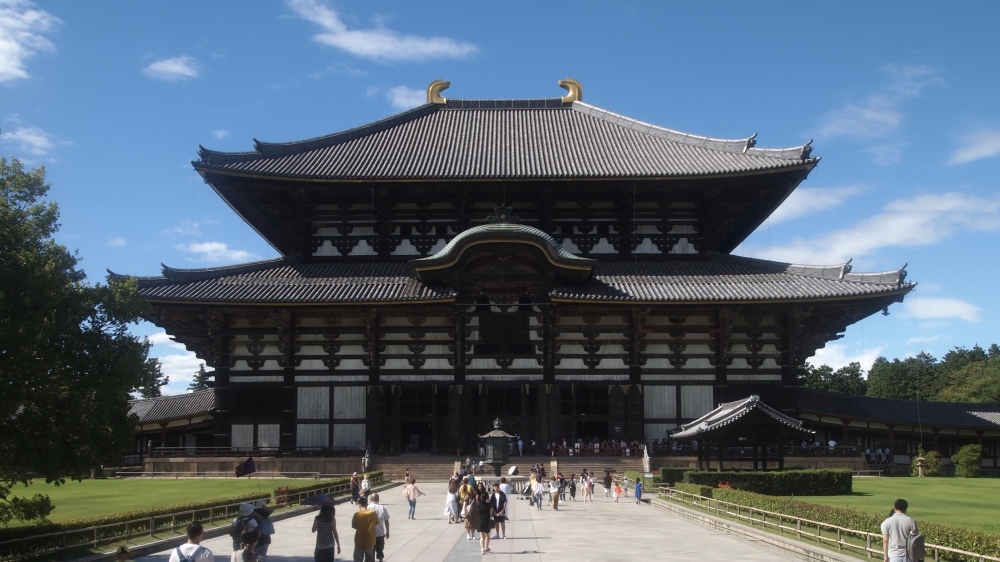
Todai-ji

Todai-ji

Todai-ji

Todai-ji

Todai-ji
The Daibutsu (Great Buddha) inside, originally cast in 746, is one of the largest bronze sculptures in the world. At one time it was covered in gold leaf, quite an impressive sight for Japanese 8th century visitors. The present statue, recast in the Edo period (1603 – 1868), stands 15 meters tall; the seated Buddha represents Vairocana, the cosmic Buddha believed to give rise to all worlds and their respective Buddhas (Lonely Planet Japan), and is flanked by two Bodhisattvas.

Daibutsu

Daibutsu
The Kokuzo Bosatsu, seated to the left of the Daibutsu, is the Bodhisattva of memory and wisdom. Students pray to him for help in their studies, while the faithful pray for enlightenment. Standing to the left of the Daibutsu and the Kokuzo Bosatsu is Komokuten, a guardian of the Buddha. He stands upon a demon (jaki), which symbolizes ignorance, and holds a brush and scroll, which symbolizes wisdom (Lonely Planet Japan).

Daibutsu

Daibutsu

Kokuzo Bosatsu

Komokuten
A pillar with a hole in its base is supposedly the same size as the Daibutsu’s nostril. It is said that those who can squeeze through this opening will be granted enlightenment in their next life (japan-guide.com: Todai-ji Temple). I watch as a boy squeezes through the hole. I guess he will have guaranteed enlightenment!

Hole in Pillar

Hole in Pillar

Hole in Pillar
I always love to check out the ema at every temple, and I find this cute one at Tōdai-ji: “I wish my family won’t be angry at Matthias. Hooray.”

Ema at Todai-ji

Ema at Todai-ji
Seated to the right of the Daibutsu is Nyoirin Kannon, one of the Bodhisattva that preside over the six realms of karmic rebirth.

Nyoirin Kannon

Nyoirin Kannon

Daibutsu
Pindola was one of the sixteen arahats, who were disciples of the Buddha. Pindola is said to have excelled in the mastery of occult powers. It is commonly believed in Japan that when a person rubs a part of the image of Binzuru (Pindola Bharadvaja) and then rubs the corresponding part of his own body, his ailment there will disappear.

Binzuru
The Tōdai-ji grounds are quite verdant at this time of year.

Todai-ji grounds

Todai-ji grounds

Todai-ji grounds
Nigatsu-dō lies to the east of the Great Buddha Hall and up the side of Mount Wakakusa. Nigatsu-dō (which translates to “The Hall of the Second Month”) is a beautiful hall that overlooks the city of Nara and provides a view of its ancient structures. To get to it, I walk through peaceful neighborhoods lined with lanterns, a welcome relief after the crowds at Tōdai-ji.

walking to Nigatsu-dō

walking to Nigatsu-dō

inside cafe at Nigatsu-dō

doors at Nigatsu-dō
I line up with other visitors along Nigatsu-dō’s balcony to absorb the views.

Nigatsu-dō

view of Nara from Nigatsu-dō
The original construction of Nigatsu-dō hall is estimated to have completed somewhere between 756 and 772. Nigatsu-dō was destroyed in 1667 due to a fire. Re-construction of Nigatsu-dō was completed in 1669. In 1944, it was chosen by Japan as one of the most important cultural assets of the country. This sub-temple of Tōdai-ji reminds me of Kiyomizu-dera, which I visited in Kyoto in 2011 (golden pavilions, rock gardens, bamboo groves, and white-gloved train conductors).

roof at Nigatsu-dō

lanterns at Nigatsu-dō

view from Nigatsu-dō

lanterns at Nigatsu-dō

view from Nigatsu-dō

lanterns at Nigatsu-dō
I love all the lanterns at Nigatsu-dō.

Nigatsu-dō

Nigatsu-dō

Nigatsu-dō

Nigatsu-dō

ema at Nigatsu-dō

ema at Nigatsu-dō
Nigatsu-dō is quite majestic sitting high on the hill.

Nigatsu-dō

steps to Nigatsu-dō
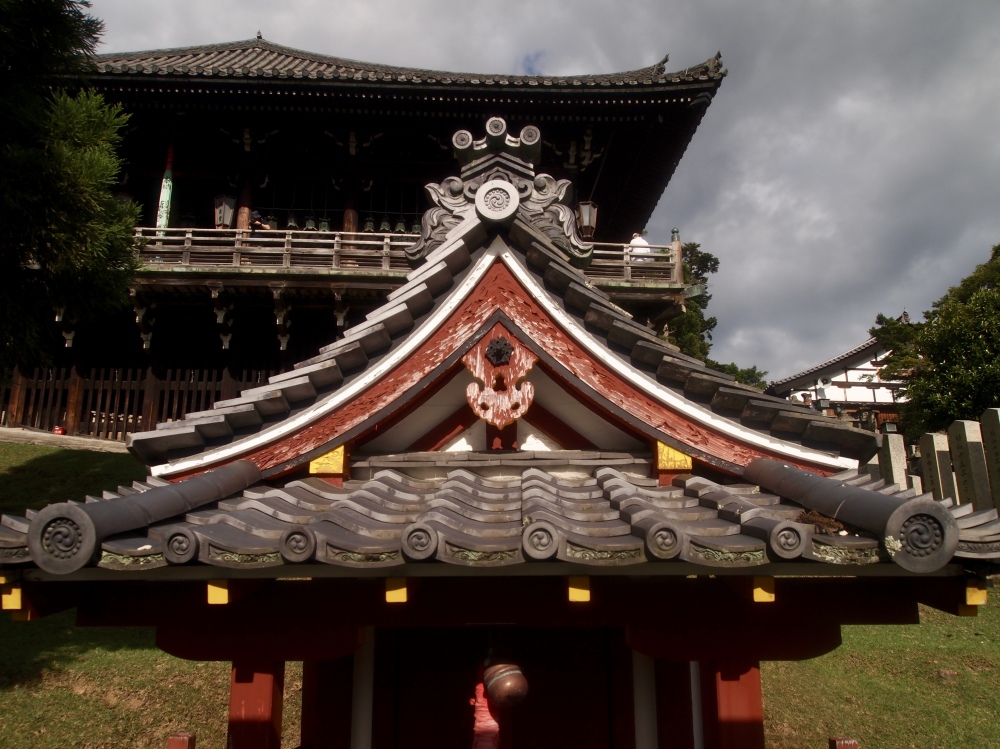
Nigatsu-dō

shrine at Nigatsu-dō

Nigatsu-dō

Nigatsu-dō

Nigatsu-dō

Nigatsu-dō
Nigatsu-dō is best known for Omizutori, a fire and water ceremony on March 12 every year, where huge flaming torches are held out from the temple balcony. The next day, sacred water is drawn from a well under the temple, which is said to have healing properties. The ceremony has been held here without a break since the temple’s founding in 752 (Visit Nara: Nigatsu-do).

Nigatsu-dō
Sangatsu-do Hall is home to a small collection of Nara-period statues.

Sangatsu-do Hall

Sangatsu-do Hall
Tamukeyama Hachimangu is a Hachiman shrine, dedicated to the kami Hachiman, a divinity of archery and war. It was established in 749. Kami, spirits or phenomenon worshiped in the Shinto religion, enshrined here include: Emperor Ōjin, the 15th emperor of Japan; Emperor Nintoku, the 16th emperor; Empress consort Jingū, who ruled beginning in the year 201; and Emperor Chūai, the 14th emperor.

Tamukeyama Hachimangu

Tamukeyama Hachimangu

ema at Tamukeyama Hachimangu

ema at Tamukeyama Hachimangu

Tamukeyama Hachimangu

Tamukeyama Hachimangu

ema at Tamukeyama Hachimangu

Tamukeyama Hachimangu

ema at Tamukeyama Hachimangu

Tamukeyama Hachimangu

Tamukeyama Hachimangu
After leaving Tamukeyama Hachimangu, I make my way back to Tōdai-ji, passing a spiral sōrin, circling Kagami-ike Pond, and finally walking under Nandaimon Gate. Nara’s deer keep me company the whole way.

sōrin at Tōdai-ji

Kagami-ike Pond

Kagami-ike Pond

Kagami-ike Pond

deer of Nara
As I’m leaving Tōdai-ji, I walk through the Nandaimon Gate, a large wooden gate, rebuilt in the 13th century, watched over by two fierce-looking statues. Representing the Nio Guardian Kings, the statues are designated national treasures together with the gate itself.

Nandaimon Gate
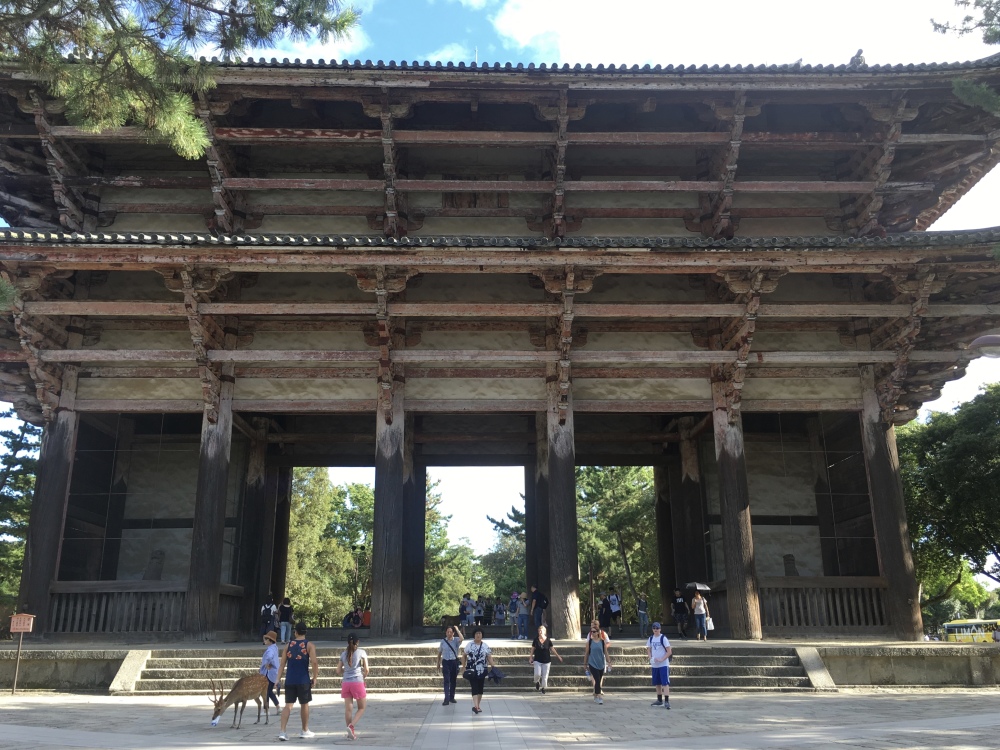
Nandaimon Gate

deer of Nara

deer of Nara
Nandaimon Gate is impressive in its size and ancient grandeur.

Nandaimon Gate
The deer of Nara are everywhere!

deer in Nara

Nara’s deer

deer

deer in Nara

deer in Nara

deer in Nara
Nara’s deer are having a rest near the main gate, undoubtedly perspiring in this sizzling weather.
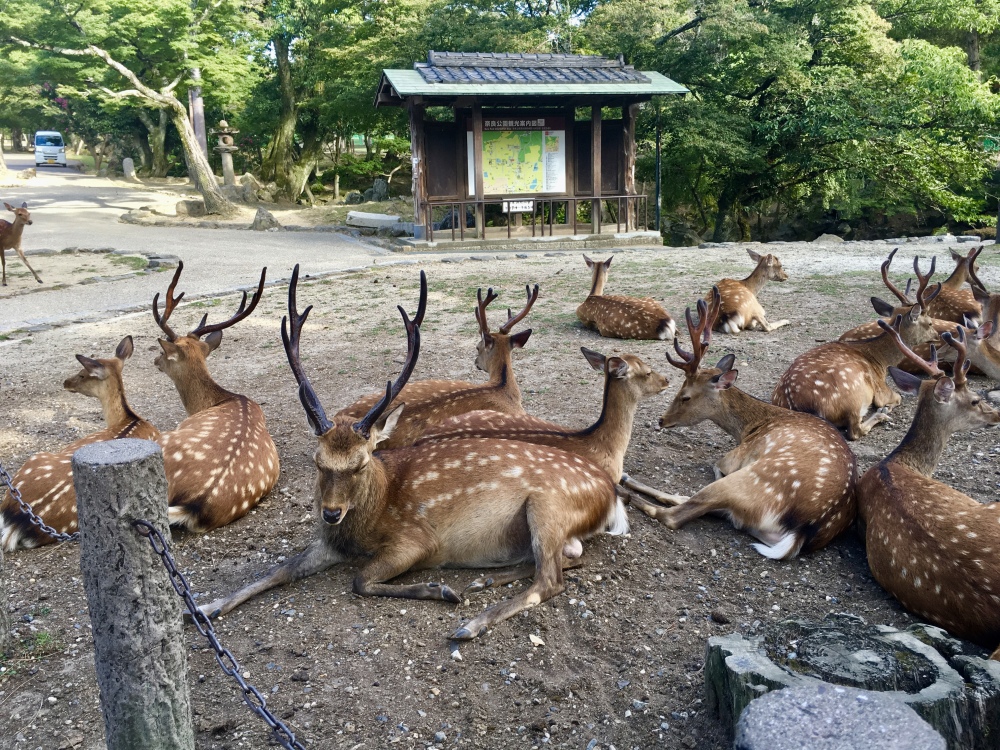
Nara’s deer
After taking a shower back at my hotel, I go into Nara Proper to have a Pizza Margherita at the Mellow Cafe.

mellow cafe
On the way back to my hotel, I stop for an ice cream with a little deer on top. It provides a bit of welcome relief from the heat

pizza at mellow cafe

me with ice cream in Nara
Tomorrow, I’ll explore more of Nara.
Steps today: 15,835 (6.71 miles)



























































































































































































































































































































